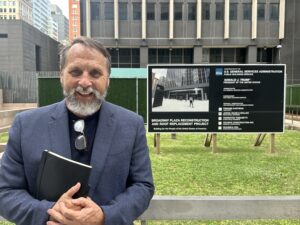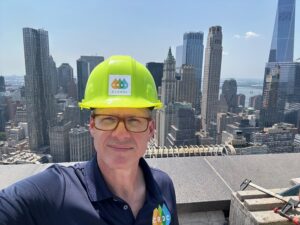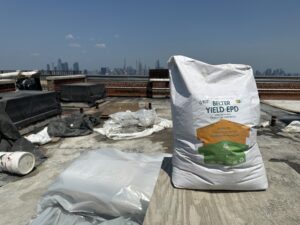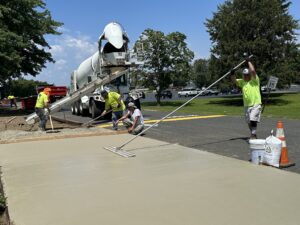
Donald Thomson hates to see plastic go to waste. Literally. The Canadian-born builder and entrepreneur –– who has lived in Costa Rica for the past 34 years –– has gone through many phases in his mission to find viable, long-term applications for plastic waste.
What began in 2010 as a volunteer-based beach cleanup project dubbed the Center of Regenerative Design & Collaboration, or CRDC, has morphed into something much bigger and more impactful.
What became known as CRDC Global Ltd. has now adopted the name CRDC Materials, a green building materials and machinery technology company. It currently has four plants worldwide and ambitious plans to grow that exponentially. The company’s core recycled-content product is called RESIN8®, a hybrid mineral-polymer aggregate that looks and behaves like construction sand, but does much more for the environment.

“Today,” the 50-employee company says, “our team and partners manufacture RESIN8 recycled content from hard-to-recycle, mixed plastic waste in Costa Rica, South Africa, Australia, and the United States, and export our products globally.”
Concrete enriched with RESIN8 can be lighter, more durable, and more energy efficient than standard concrete –– while consuming vast amounts of waste plastic. RESIN8 in asphalt reduces deformation and extends pavement life. Studies have shown that adding RESIN8 recycled content to concrete increases project costs by as little as 0.11 percent, while adding significant environmental and durability benefits.
Thomson said in a recent phone interview that CDRC’s “20/20 Vision” for continuous expansion aims to initiate additional RESIN8 manufacturing in at least 20 cities globally, with each processing difficult-to-recycle plastics into 20,000 tons of the end product per year.
In North America, the firm currently is looking closely at establishing RESIN8 plants in Buffalo, N.Y.; Sacramento, CA; and Ontario, Canada, with another five to 10 sites in the pipeline. It recently won sustainability awards in Dubai, Mexico and California.
Sky-High Ambitions
One of CRDC Materials’ latest high-profile projects involves re-roofing the top of a New York City high-rise –– the Jacob Javits Federal Building at 26 Federal Plaza, which is headquarters to the Federal Bureau of Investigation (FBI), the Department of Homeland Security (DHS), the U.S. Social Security Administration, and the New York Immigration Court, among others. At 587 feet, it is the tallest federal building in the country.

Ross Gibby is co-founder of CRDC Materials and since 2019 has been CEO of the firm’s North America operations. He explained in the same interview that it’s not possible to pump concrete up to the roof, so it must be transported up in bags. These bags move up the freight elevator on pallets to the 41st floor, and then have to be hoisted up via a pulley system for the final six floors. The concrete is mixed and applied on the roof. This project requires 10,000 bags. Because of its lower bulk density, each bag weighs about 20 percent less than traditional concrete mix.
CRDC partnered on the project –– its fourth in New York to use this particular concrete mix –– with Atlanta-based Belter Tech, which is focused on decarbonizing construction. After all, the built environment sector is responsible for nearly 15 percent of global greenhouse gas emissions and 30 percent of landfill waste.

The specific Belter Tech mix being used for the Federal Plaza rooftop is called Belter Yield EPD, which it infuses with 40 percent reclaimed materials. This lightweight mix offers 58 percent greater coverage than a similar amount of traditional concrete while also yielding superior crack resistance and adhesion to substrates.
Belter Tech CEO Gerald Hughes declares online: “We’re proudly making it possible for even the most demanding projects to use American-made materials that reduce waste and pollution, with zero compromise in performance.”
CRDC got the plastic waste for this project from its York, PA, plant. “We get about 25 percent of the material from the community via a drop-off program at our plant,” Gibby said. “We also have additional sources of material.” The firm gets plastic waste from hospitals in the WellSpan Health network of healthcare facilities in central Pennsylvania, and from Wegman’s supermarkets in both Pennsylvania and New York.
Accelerate your sustainability management and performance no matter where you are on your journey, learn more here!
Making Use of Hospital Plastic Waste
CRDC receives non-hazardous plastic waste from four areas of the WellSpan hospitals:
* Surgical services/operating rooms (all the pre-packaging of instrumentation as well as so-called “blue wrap,” which are polymer-based fabrics, such as patient gowns, etc.);
* The dialysis unit (mostly bottles and plastic packaging);
* Food service/kitchen (bottles, bags, shrink wrap, etc.);
* Materials management/receiving (shrink wrap, bubble wrap, Styrofoam, etc.)
“We take all resin types, Numbers 1 through 7.” Gibby said. “That’s what’s unique about us from the plastic waste management. We receive a huge percentage of films and flexible plastics –– it’s very lightweight. We don’t get a massive percentage of rigids.” These films and flexibles represent some of the least-recycled plastics in the market, he noted.
“One of the benefits of RESIN8,” added Thomson, “is the flexibility in the mix. It depends on what’s coming in the door. We mix to a bulk density. We don’t have a specific recipe. We can take any [plastics labeled] from #1 to #7.” CRDC’s target for the product is a bulk density of 450 to 500 kilograms per cubic meter.
Gibby noted that RESIN8 also has been used on a floor in One Penn Plaza, the home of Madison Square Garden and other various projects.
N.J. School Opts for ‘Greener’ Sidewalks

One of those is at St. Benedict Catholic Church and School in Holmdel, N.J. In collaboration with the Synthetic Aggregate Association. The pre-K through 8th grade school recently replaced sidewalks and curbs around its campus with 131 yards of RESIN8-enhanced concrete that incorporated diverse types of recycled waste materials, including plastics, foams, baling twine, and glass.
The school project “is a small demonstration of how construction can lower its carbon footprint by substituting mined natural aggregates with synthetic ones made from hard-to-recycle materials,” according to CRDC Materials. The project repurposed the equivalent of approximately 59,415 plastic water bottles, along with an estimated 25,200 glass containers used as ground glass pozzolan (GGP)—a key ingredient improving strength and sustainability in concrete.
Thomson said in mid-September that the company was in the midst of raising $16 million in funding in its first time to formally go to the market. He said that CRDC is still in the red, but “is very close to being in the black.”
“There’s not much money to be made in plastics,” he acknowledged. “But there is money to be made in the construction sector.”
The views, opinions and technical analyses presented here are those of the author or advertiser, and are not necessarily those of ULProspector.com or UL Solutions. The appearance of this content in the UL Prospector Knowledge Center does not constitute an endorsement by UL Solutions or its affiliates.
All content is subject to copyright and may not be reproduced without prior authorization from UL Solutions or the content author.
The content has been made available for informational and educational purposes only. While the editors of this site may verify the accuracy of its content from time to time, we assume no responsibility for errors made by the author, editorial staff or any other contributor.
UL Solutions does not make any representations or warranties with respect to the accuracy, applicability, fitness or completeness of the content. UL Solutions does not warrant the performance, effectiveness or applicability of sites listed or linked to in any content.
